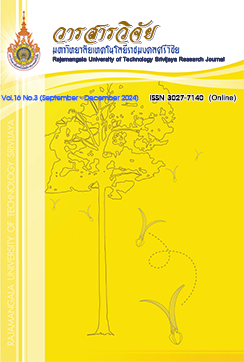The Development of Semantic Thai Herb Knowledge Mining for Treatment
Keywords:
knowledge mining, ontology, machine learning, Thai herbAbstract
Using Thai herbs for treating is an alternative medicine that helps take care of people’s preliminary health and relieves them from diseases and symptoms. This is an important topic that leads to operating this research aimed at: 1) creating the ontology and the rules for searching the semantic Thai herb knowledge, 2) developing semantic Thai herb knowledge mining, and 3) assessing the efficiency of extracting Thai herb semantic knowledge and classifying the Thai herbs’ class. The Thai herb knowledge was collected from 100 websites to build an ontology and extract the semantic knowledge using SWRL with natural language processing. The performance is measured in extracting the semantic knowledge and predicting the classification of herb classes using the neural network (NN), the support vector machine (SVM), the K-nearest neighbor (KNN), and the decision tree (DT). The results show that Thai herb ontology was divided into 2 knowledge classes and comprised eight knowledge nodes. SWRL rules were created to extract the knowledge structures identifying the herb data pattern in 3 types: Zingiber montanum, Tiliacora triandra, and Andrographis paniculate. The ML processing on semantic Thai herb knowledge mining consisted of 4 parts: 1) semantic processing on ontology, 2) extracting the knowledge mining, 3) creating the Thai herb dataset, and 4) predicting the results using ML. The results of assessing the semantic Thai herb knowledge retrieval performance using the ontology and the SWRL rules yielded an F-measure value of 94.8%. The NN had the highest accuracy in predicting Thai herb classes at 90.0% and the KNN had the lowest accuracy at 82.2%.
References
Aldana Martín, J.F., García Nieto, J., Roldán García, M.M. and Aldana Montes, J.F. 2022. Semantic modelling of Earth Observation remote sensing. Expert Systems with Applications 187(C): 115838.
Chamnongsri, N. 2019. Ontology Development for Thai Herbal Medicine Recorded in Ancient Documents. Journal of Information Science 37(4): 18-43. (in Thai)
Ghosh, S., Ghosh, A., Ghosh, B. and Roy, A. 2022. Plagiarism Detection in the Bengali Language: A Text Similarity-Based Approach, pp. 1-4. In 3RD International Conference on Engineering and Advancement in Technology (ICEAT 2022). Lisbon, Portugal.
Hillen, J. 2019. Web scraping for food price research. British Food Journal 121(12): 3350-3361.
Ibrahim, A.F. 2022. Application of various machine learning techniques in predicting coal wettability for CO2 sequestration purpose. International Journal of Coal Geology 252(14): 103951.
Jordan, J. 2017. Neural networks: training with backpropagation. Available Source: https://www. jeremyjor dan. me/neural-networks-training, June 9, 2022.
Kliangkhlao, M., Kochakornjarupong, D. and Boonchoom, V. 2015. An Ontology Development for Personal Health Adaptation Related to Climate Change. Thaksin University Journal 18(1): 23-31. (in Thai)
Miao, J. and Zhu, W. 2021. Precision–recall curve (PRC) classification trees. Evolutionary Intelligence 15(3): 1545-1569.
Ministry of Public Health. 2008. Notification of Ministry of Public Health 2008 Title: Management plan to protect herbs in Phu Pha Kood Conservation Area Mukdahan Province According to the Protection and Promotion of Thai Traditional Medicine Knowledge Act the Protection and Promotion of Thai Traditional Medicine Wisdom Act 1999. Government Gazette vol.125, Special Part 42. (dated February 28, 2008). (in Thai)
Noy, N. and McGuinness, D. 2001. Ontology development 101: A guide to creating your first ontology. Stanford University, Stanford.
Po, D.K. 2020. Similarity Based Information Retrieval Using Levenshtein Distance Algorithm. International Journal of Advances in Scientific Research and Engineering 6(4): 6-17.
Polenghi, A., Roda, I., Macchi, M. and Pozzetti, A. 2022. An ontological modelling of multi-attribute criticality analysis to guide Prognostics and Health Management program development. Autonomous Intelligent Systems 2(1): 1-16.
Pongsanguan, W., Thinsungnoen, T. and Thinsungnoen, M. 2018. Development of Model for Diabetes Mellitus Using Decision Tree Technique. Journal of Science and Technology 1(1): 1-8. (in Thai)
Prompukdee, C., Rungrattanaubol, J. and Na-udom, A. 2017. Applying Data Mining Techniques on Thai Traditional Medicine Treatment. NU. International Journal of Science 14(1): 24-36. (in Thai)
Ruger, Y., Kabmala, M. and Chansanam, W. 2022. Ontology Rules for Library Research Services Recommendation System. International Journal of Information and Education Technology 12(9): 831-839.
Sun, B., Du, J. and Gao, T. 2009. Study on the Improvement of K-Nearest-Neighbor Algorithm, pp. 390-393. In International Conference on Artificial Intelligence and Computational Intelligence 2009. Shanghai, China.
Tian, D., Li, M., Zhang, X., Han, S. and Shen, Y. 2023. Intelligent Question Answering Method for Construction Safety Hazard Knowledge Based on Deep Semantic Mining. Automation in Construction 145: 1-13.
Tungkwampian, W., Theerarungchaisri, A. and Buranarach, M. 2015. Development of Thai herbal medicine knowledge base using ontology technique. The Thai Journal of Pharmaceutical Sciences 39(3): 102-109.
Wang, S., Mathew, A., Chen, Y., Xi, L., Ma, L. and Lee, J. 2009. Empirical analysis of support vector machine ensemble classifiers. Journal of Expert Systems with Applications 36(3): 6466-6476.
Xiuyi, T. and Yuxia, G. 2018. Research on Application of Machine Learning in Data Mining. Journal of Materials Science and Engineering 6(392): 1-4.
Yaiprasert, C. and Yusakul, G. 2022. Artificial intelligence for target symptoms of Thai herbal medicine by web scraping. International Journal of Data and Network Science 6(3): 1013-1022. (in Thai)
Downloads
Published
How to Cite
Issue
Section
License
Copyright (c) 2024 Rajamangala University of Technology Srivijaya Research Journal

This work is licensed under a Creative Commons Attribution-NonCommercial-NoDerivatives 4.0 International License.
The content and information in the article published in Journal of Rajamangala University of Technology Srivijaya It is the opinion and responsibility of the author of the article. The editorial journals do not need to agree. Or share any responsibility.







